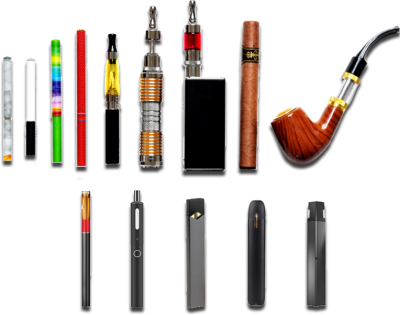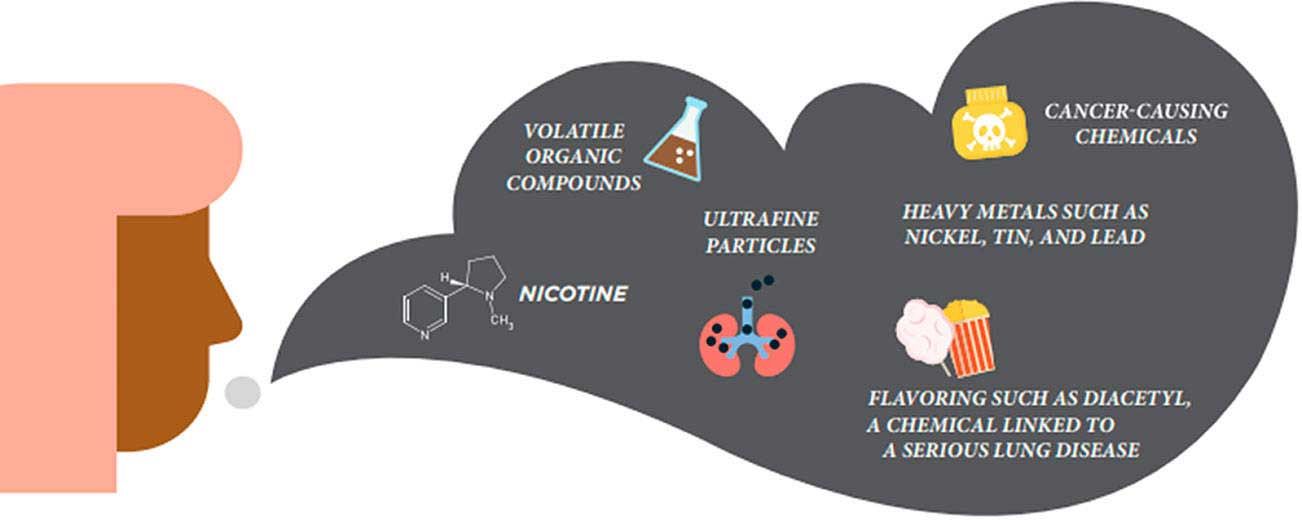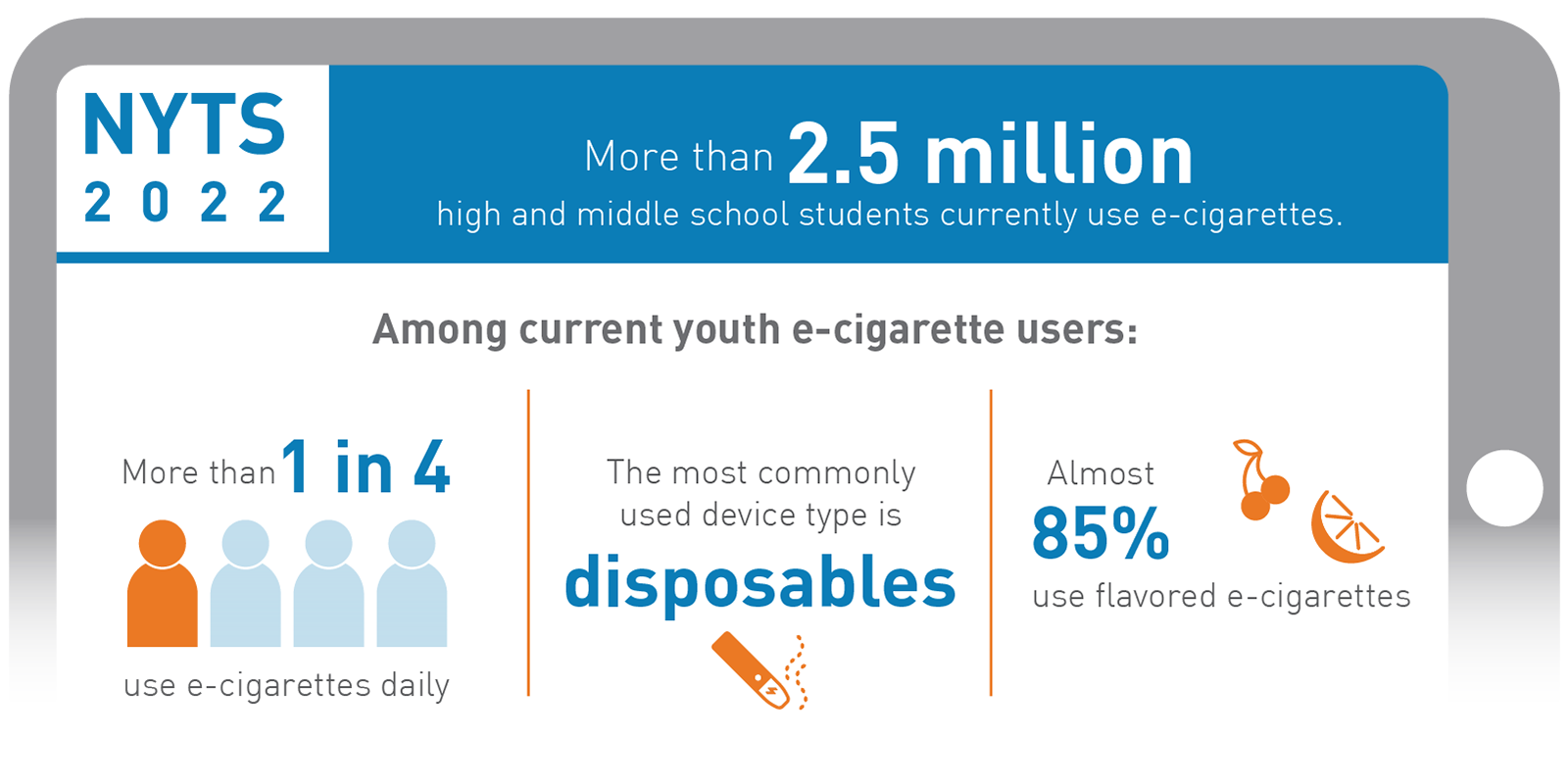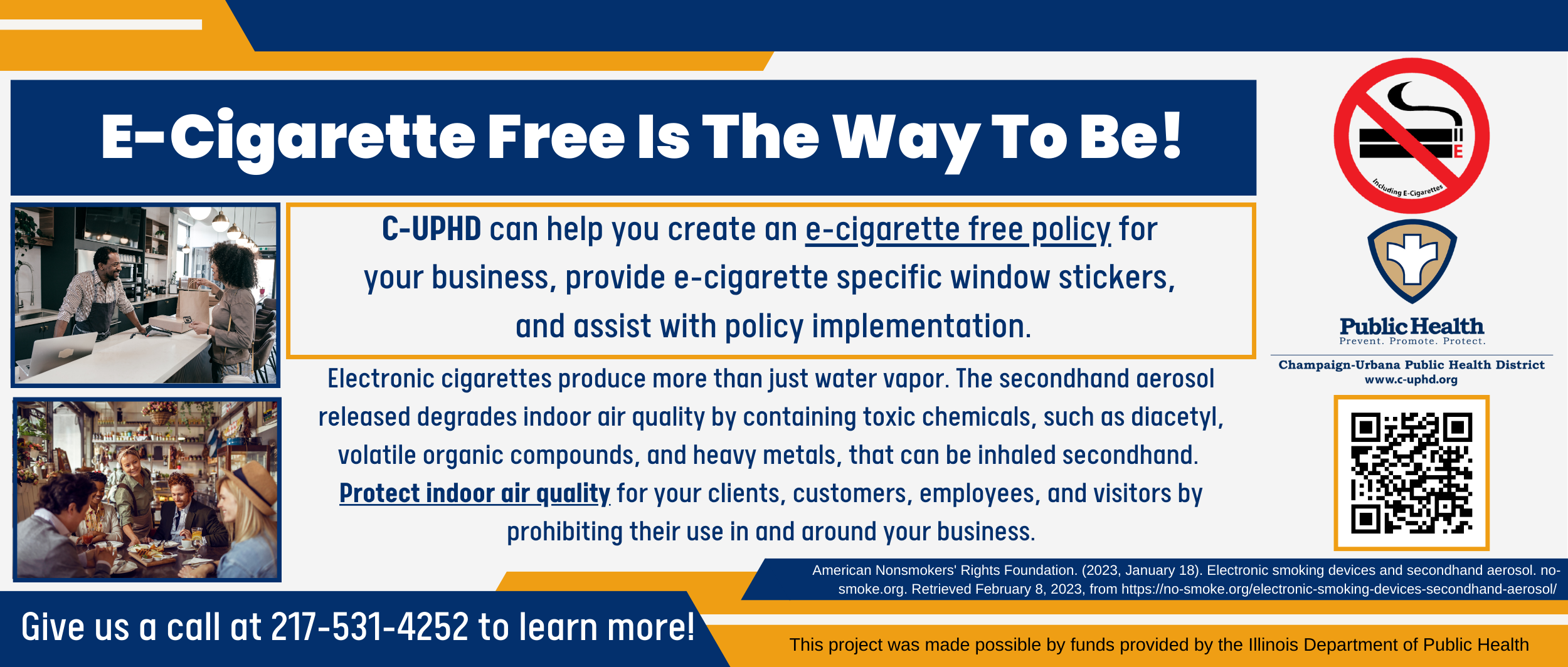E-Cigarettes
What is an E-Cigarette?

Electronic cigarettes, or e-cigarettes, are devices that use a heating element to turn flavored liquids into an aerosol that the user inhales. Most of these devices are used to deliver nicotine to the user, which is why another name for them are ENDS (electronic nicotine delivery systems). E-cigarette devices come in a wide variety of shapes, sizes, and styles. Some resemble other tobacco products, such as cigarettes, cigars, or pipes. You may hear them referred to as e-cigs, e-cigars, vapes, vape pens, mods, carts, tanks, dab pens, e-hookah, ENDS, or by their brand name, like JUUL or Puff Bar. The act of using an e-cigarette device is often called “vaping” or "hitting a vape".
E-Cigarette Liquids

Some e-cigarettes are disposable, while others are made to be reusable by refilling the device with liquid purchased separately. These liquids come in thousands of flavors and varying levels of nicotine; some may contain other compounds, like CBD or THC. The ingredients, including nicotine levels, vary between brands and flavors, but many products are not thoroughly or accurately labeled. This liquid may be referred to as e-liquid, e-juice, or vape juice.
What's in the Aerosol?
Despite the commonly used term “vaping”, the substance inhaled and exhaled by an e-cigarette user is not vapor; it is an aerosol containing several potentially harmful chemicals and particulates. Some of the harmful ingredients include nicotine, propylene glycol (found in antifreeze), carcinogens (cancer-causing chemicals), diacetyl (toxic chemical linked to popcorn lung), benzene (volatile organic compound found in car exhaust), and heavy metals (nickel, tin, and lead). These chemicals are also released into the air when the user exhales and can be inhaled secondhand by others.2

Health Effects
Since e-cigarettes are a relatively new product, there is still a lot of research needed to be done on the long-term health effects. While studies have shown that e-cigarette aerosol is less harmful than traditional tobacco smoke, that does not mean that it is safe. E-cigarette aerosol has been found to contain lung irritants, cancer-causing chemicals, heavy metals, volatile organic compounds, and usually nicotine.
One thing that we know for certain is the harm caused by nicotine, which most e-liquids contain. Nicotine is a highly addictive substance, and it is especially harmful to pregnant people and unborn fetuses, and to the developing brains of children and young adults. People with developing brains (under 25) become addicted to nicotine much easier than those with fully developed brains. The chemicals in e-cigarettes can affect one physically and mentally.3
Short term physical side effects can include headaches, nausea, vomiting/diarrhea, trouble sleeping, dry mouth, and acute lung injury. Longer term physical side effects can include irreversible lung damage, COPD, asthma, lung cancer, hypertension, insulin resistance/high insulin, and blood clots. Mental and cerebral side effects can include changes in brain chemistry over time, depression, anxiety, irritability, and being more susceptible to become addicted to other substances.3
E-Cigarettes and Youth
The Center for Disease Control reports that since 2014, e-cigarettes have been the most commonly used tobacco product among U.S. middle and high school students. Most e-cigarettes contain nicotine, which is highly addictive, can harm the developing adolescent brain, and can increase risk for future addiction to other drugs. 5
In October 2022, FDA Commissioner Robert M. Califf, M.D. stated, “The FDA remains deeply concerned about e-cigarette use among our nation’s youth. It’s clear that we still have a serious public health problem that threatens the years of progress we have made combatting youth tobacco product use” 6.
Youth Tobacco Survey 4

Findings from the 2022 National Youth Tobacco Survey (NYTS) show 14.1% of high school students and 3.3% of middle school students reported current e-cigarette use. 5
In 2022, 2.55 million U.S. middle and high school students currently used e-cigarettes.
Among students who report e-cigarette use, approximately 7 out of 10 used fruit flavors.
Disposable products were the most commonly reported device type.
E-Cigarettes and Cessations
E-cigarettes have not been approved by the FDA as a smoking cessation device, so consumers should exercise caution with this method. The American Lung Association recommends quitting, not switching. E-cigarettes themselves are very addictive, since most of them contain nicotine, and many who intend to use e-cigarettes to quit traditional smoking may find themselves continuing to use both products (dual use).
For help with quitting traditional smoking or an e-cigarette addiction, consult the resources below and/or speak with your doctor. The American Lung Association recommends creating a smoking plan that includes medication plus counseling, as this combination has the highest rates of success in permanently quitting smoking.
- Illinois Tobacco Quitline
- Call 1-866-QUIT-YES
- Free phone counseling for Illinois residents
- Now available to 13-17-year-olds, no parental consent required
- Free nicotine patches, gum, and lozenges for those eligible
- Truth Initiative This is Quitting text line
- Text DITCHVAPE to 88709
- Tailored based on 13-24-year-olds
- Users will receive one age-appropriate message per day tailored to their quit date, which can be set and reset via text
- Smokefree.gov Quit Plan
- American Lung Association Freedom from Smoking
- Go to https://www.lung.org/quit-smoking/join-freedom-from-smoking
- In-person group clinics led by a certified facilitator featuring a step-by-step plan for quitting smoking, or
- Self-help guide to lean on to quit smoking
- Staffed by respiratory therapists and certified tobacco treatment specialists to answer any questions you have
- American Lung Association N-O-T (Not on Tobacco) Program
- In-school e-cigarette/vaping cessation program
- Ten, 50-minutes sessions

Sources:
- https://www.cdc.gov/tobacco/basic_information/e-cigarettes/pdfs/ecigarette-or-vaping-products-visual-dictionary-508.pdf
- https://www.lung.org/quit-smoking/e-cigarettes-vaping/whats-in-an-e-cigarette#:~:text=E%2Dcigarettes%2C%20aka%20JUULs%20and,glycol%2C%20flavorings%20and%20other%20chemicals
- https://www.bevapefree.org/just-the-facts-vft/
- https://www.fda.gov/tobacco-products/youth-and-tobacco/results-annual-national-youth-tobacco-survey
- https://www.cdc.gov/mmwr/volumes/71/wr/mm7140a3.htm?s_cid=mm7140a3_w
- https://www.fda.gov/news-events/press-announcements/new-data-show-more-25-million-us-youth-currently-use-e-cigarettes
Complete the Community Menthol Survey
Directions: The Champaign-Urbana Public Health District is collecting community opinions about menthol tobacco product use and its impact. Community responses and comments will remain confidential and be compiled to assist with policy creation efforts. Thank you for taking the time to learn more about menthol products and complete the Menthol Survey.
Hours and Contact Information
Monday - Friday 8:00 a.m. - 4:00 p.m.
Phone: 217-373-7901
Fax: 217-353-7767
201 W. Kenyon Rd., Champaign, IL 61820
